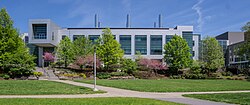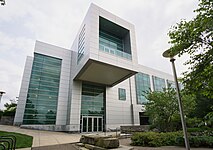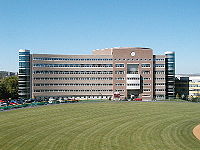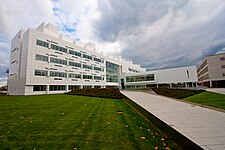
The State University of New York at Albany is a public research university with campuses in Albany, Rensselaer, and Guilderland, New York. Founded in 1844, it is one of four "university centers" of the State University of New York (SUNY) system.

The J. B. Speed School of Engineering is the engineering college of the University of Louisville, a public research university in Louisville, KY.

The University of Colorado Colorado Springs (UCCS) is a public research university in Colorado Springs, Colorado. It is one of four campuses that make up the University of Colorado system. As of Fall 2023, UCCS had over 11,000 students, including more than 9,000 undergraduates and nearly 2,000 graduate students. It is classified among "R2: Doctoral Universities – High research activity".

The Cornell University College of Arts and Sciences is an academic college at Cornell University. It has been part of the university since its founding in 1865, although its name has changed over time. It is the largest of Cornell University's colleges and schools with 4,251 undergraduate and 1,301 students and 526 faculty.
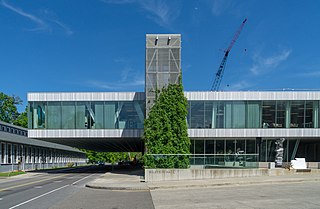
The College of Architecture, Art, and Planning (AAP) is the school of architecture at Cornell University in Ithaca, New York. It offers 20 undergraduate and graduate degrees in five departments: architecture, art, urban planning, real estate, and design technology. Aside from its main campus in Ithaca, AAP offers programs in Rome, Italy and in New York City, New York.
The School of Engineering and Applied Science (SEAS) at the George Washington University in Washington, D.C. is a technical school which specializes in engineering, technology, communications, and transportation. The school is located on the main campus of the George Washington University and offers both undergraduate and graduate programs.
The Engineering Campus is the colloquial name for the portions of campus surrounding the Bardeen Quadrangle and the Beckman Quadrangle at the College of Engineering at the University of Illinois Urbana–Champaign. It is an area of approximately 30 square blocks, roughly bounded by Green Street on the south, Wright Street on the west, University Avenue on the north, and Gregory Street on the east.

The University of Oklahoma College of Engineering in the engineering unit of the University of Oklahoma in Norman. It has an enrollment of 2,086 undergraduates and 2,193 graduate students,. In 2009, 257 bachelor's degrees, 92 master's degrees and 29 doctoral degrees were conferred.
The James McKelvey School of Engineering is a part of Washington University in St. Louis. Founded in 1854, the engineering school is a research institution occupying seven buildings on Washington University's Danforth Campus. Research emphasis is placed on cross-disciplinary technologies in the areas of alternative energy, environmental engineering & sustainable technology, biotechnology, information technology, and nanotechnology/materials science.

The Herbert Wertheim College of Engineering is the largest professional school, the second largest college, and one of the top three research units at the University of Florida. The college was founded in 1910, and in 2015 was named in honor of Herbert Wertheim – a serial inventor, philanthropist and UF Distinguished Alumnus. Located on the university's Gainesville, Florida campus, the college is composed of nine departments, 15 degree programs, and more than 20 centers and institutes. It produces research and graduates in more than a dozen fields of engineering and science including: aerospace, agricultural, biological, biomedical, chemical, civil, coastal, computer, computer science, digital arts, electrical, environmental, industrial, materials, mechanical, nuclear, and systems.
The College of Engineering and Applied Science is the engineering and applied science college of the University of Cincinnati in Cincinnati, Ohio. It is the birthplace of the cooperative education (co-op) program and still holds the largest public mandatory cooperative education program at a public university in the United States. Today, it has a student population of around 4,898 undergraduate and 1,305 graduate students and is recognized annually as one of the top 100 engineering colleges in the US, ranking 83rd in 2020.

The Henry Samueli School of Engineering (HSSoE) is the academic unit of the University of California, Irvine that oversees academic research and teaching in disciplines of the field of engineering. Established when the campus opened in 1965, the school consists of five departments, each of which is involved in academic research in its specific field, as well as several interdisciplinary fields. The school confers Bachelor of Science, Master of Science, and Doctor of Philosophy degrees.
The Irwin and Joan Jacobs School of Engineering is an undergraduate and graduate-level engineering school offering BS, BA, MEng, MS, MAS and PhD degrees at the University of California, San Diego in San Diego, California. The Jacobs School of Engineering is the youngest engineering school of the nation's top ten, the largest by enrollment in the University of California system, as well as the largest engineering school on the West Coast and the ninth-largest in the country. More than thirty faculty have been named members of the National Academies. The current dean of the Jacobs School of Engineering is Albert P. Pisano.
The University of Texas at Arlington (UTA) College of Engineering is a college of engineering at the University of Texas at Arlington in Arlington, Texas. The engineering program was established in 1959 when Arlington State College was officially given the status of a senior college. The college currently offers 11 baccalaureate, 14 master's, and nine doctoral degrees. The College of Engineering celebrated its 50th anniversary in 2009 and is the third largest engineering program in Texas.

Central Campus is the primary academic and administrative section of Cornell University's main campus in Ithaca, New York. It is bounded by Libe Slope to its west, Fall Creek to its north, and Cascadilla Creek to its south.

The Virginia Tech College of Engineering is the academic unit that manages engineering research and education at Virginia Tech. The College can trace its origins to 1872, and was formally established in 1903. Today, The College of Engineering is the largest academic unit of Virginia Tech and has 14 departments of study. Its undergraduate program was ranked 4th and its graduate program was ranked 30th among doctoral-granting universities by U.S. News & World Report in 2018. In 2014–15, the College of Engineering consisted of 10,059 students. The current dean is Dr. Julia Ross.

The College of Engineering is a college within the University of Notre Dame. The Dean of the College of Engineering is Patricia J. Culligan, Ph.D. Its graduate school for Engineering is ranked #47 in the USA and #15 for undergraduate.

The Syracuse University College of Engineering and Computer Science is one of the 13 schools and colleges of Syracuse University. The College offers more than 30 programs in four departments – Biomedical and Chemical Engineering; Civil and Environmental Engineering; Electrical Engineering and Computer Science; and Mechanical and Aerospace Engineering and The College.

The Cornell Ann S. Bowers College of Computing and Information Science and informally Cornell Bowers CIS, is home to three departments -- Computer Science, Information Science, and Statistics and Data Science -- at Cornell University, a private university based in Ithaca, New York.
The University of Nebraska–Lincoln College of Engineering is the engineering college at the University of Nebraska–Lincoln (NU) in Lincoln, Nebraska. NU has offered engineering classes since 1877 and the College of Engineering was formally established in 1909. Since 1970, it has also encompassed the engineering students and facilities at the University of Nebraska Omaha. Lance Perez has served as dean of the college since 2018.
